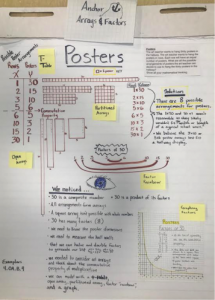Productive Discourse and Student Choice with Exemplars
Written by: Brendan Scribner, 4th Grade Teacher at the Bernice A. Ray School

For the past 22 years, I’ve enjoyed the benefits of using Exemplars math problems within my classroom. The Exemplars problems are aligned to my curriculum, promote productive discourse and enable student choice. The efficient and user-friendly website allows me to spend less time planning, and more time focusing on student sense-making, intentional sharing of student thinking, and allowing for students to debate their ideas.
Laying a Foundation for Discourse
Within my 4th grade classroom, we have established ground rules for productive student discourse. It’s important to note that this foundation is built beginning on day one of the year and slowly cultivated every day. These norms help to provide a base in which we function as a learning classroom. Students must agree with and embody the norms. Students must learn and use the talk moves. We strive to have a classroom that from an outsider perspective looks, how may I say this politely, chaotic. I strive to have my students engaged in discourse related to academic talk for a minimum of 50% of all class work. It’s important that students have ownership of the talk, and I benefit greatly as the teacher listening to the discourse and planning my moves based upon the talk in the room. With a talk structure in place, this is where the Exemplars problems shine.
Classroom Norms
Student Owned Talk Moves
The Exemplars Routine
In order to support a talk rich classroom, I need to feed the learning. The Exemplars problems are rich and engaging tasks that my students eagerly unpack. With each new unit of study, I follow an instructional routine that allows students to acquire knowledge and skills in a predictable manner.
Prior to a unit of study, I visit the Exemplars Library website and review all tasks within the standard my class will be practicing. I use the summative task as my pre/post assessment for each unit. The website features underlying mathematical concepts, possible problem-solving strategies, mathematical language and symbolic notation, a planning sheet, possible solutions, and connections. These resources are user-friendly, and help to efficiently allow you as the teacher to begin to anticipate student work that will be produced for the problems presented. It is imperative that you as the teacher solve the problem on your own, and if possible, with your teaching team as well. Unpacking the problem on your own, and with colleagues, will better prepare you for guiding discourse in your classroom.
After reviewing tasks, and administering the summative as a pre-assessment, I collate all the “more challenging versions” into one condensed handout. For a recent unit: Arrays, Factors, and Multiplicative Comparison, we focused on standards 4.OA.B.4, 4.OA.A.2. As such, we used Dog Years, Feeding Lizards and Frogs, A Jumping Good Time, Making Cakes, Boxes for Mini Muffins, The Fitness Center, Hot Dogs and Buns for Friends, Marching Ants, Posters, Puppet Shows, and Snacks on the Playground. I gathered all the problems listed for these standards within one student handout. Students have a choice of which problems they attempt to solve. Students must solve at least four, then select one of the four to present to the class. To prepare the students I engage them in unpacking the grade level version of Dog Years, using a gradual release of the problem to promote contextual understanding, student engagement, and discourse.
Here is an example of how this release occurs:
Task: Dog Years
It is said that dogs age seven years for every “people year.” Mason’s dog, Shep, was born on Mason’s eighth birthday. When Mason was nine years old, Shep was seven dog years old. If Shep is fifty-six dog years old, how old is Mason? Show all your mathematical thinking.
- Slide1: It is said that dogs age seven years for every “people year.”
- What do you notice?
- Tell me 3 things about dog or people years.
- Slide 2: Mason’s dog, Shep, was born on Mason’s eighth birthday.
- Now what do you notice?
- Are the ages of Shep and Mason a lot or a little different?
- Slide 3: When Mason was nine years old, Shep was seven dog years old. In dog years, how old will Shep be on Mason’s twelfth birthday?
- What do you wonder?
- What’s the solution?
- Estimate, how many more/less?
Using a gradual release supported by classroom norms and talk moves allows for a rich and vibrant launch into problem solving. Students apply their understandings and have time to listen to all class discourse.
As the facilitator of this conversation, I scribe a class anchor chart solution for the problem. This typically includes all of the possible solutions offered on the Exemplars site. This anchor is critical as it models how we want each student to show their thinking within their math journals for every problem opportunity.
As our discussion reaches a class consensus on a solution, I then have students begin working on the Exemplars problems for the unit of study. Students will work on problems in math class each day for a part of each class session. The first two class sessions are independent work time. During the remaining class sessions, students partner with peers to engage in shared thinking time. This includes a review of work they have done alone, as well as some time working on the same problem. Again, talk moves are leveraged during partner work. After 5–7 class periods, we will begin the process of sharing our thinking.
Strategy Share Planner
In order to engage our classroom in a thoughtful and comprehensive review of the Exemplars problems, I use a strategy share planner. Students have worked toward completing at least four (many students complete all) of the problems, and now select one to share with the class. The share time often comes outside of math class. We have used snack and lunchtime effectively to ensure that we come to closure on our problems and hear from all students equitably.
Planner
We methodically review all problems solved by the class sequentially through the handout. If more than one student chose a problem, we take turns sharing each solution. This usually means we have sustained, in-depth discussions about most of the problems within the standard. This engaged sense-making opportunity allows all to share thinking, and ultimately affords us rich debates about problem-solving strategies used by all students.
Students Create Their Own Problems
A particular draw for students is the creation of their own original problem. As a result of our process of discourse, gradual release of the anchor problem, student choice, and sharing, students are typically very ready to craft their own story problems. Students write their problem and then solve them. I encourage them to use the Exemplars problem as a template. My students love to transfer their understanding and apply their developing ideas to a context that is part of their everyday life.
Using the Exemplars platform of problems has enriched my teaching practice. The resource-rich website offers readily available story problems that engage students in the practice of making sense of the world around them and appreciate that math really is everywhere. I have noticed that the intentional gradual release of problems, shared ownership of talk moves, embedded classrooms norms, and use of a strategic planner have enhanced my students’ enjoyment and success with problem-solving. I look forward to continuing to make sense of Exemplars problems with my students for many more years.





